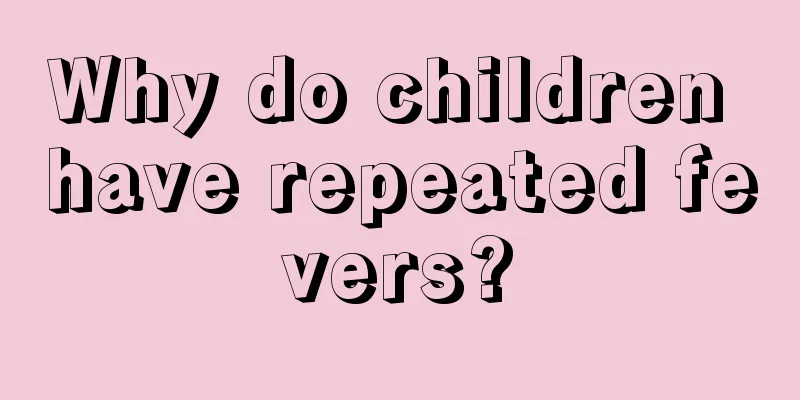What to eat when a child has a fever

|
Do you know what to eat when a child has a fever? Children with a cold and fever are particularly troublesome for parents. Many children have a very poor appetite when they are sick, so mothers try every means to make more delicious food for their babies. But the child's appetite is still not stimulated. So today we will learn about this phenomenon and what to eat when a child has a fever. Mothers with babies can learn from this and learn more ways to take good care of their babies. 1. What to eat What food is better for children to eat when they have a fever? This is a rather troublesome question, because when children have a fever, they are likely to be in a bad mood due to poor appetite. When a child has a fever, their physical energy consumption is very high, so how to arrange a suitable diet for a child with a fever is a very important issue! What food is better for children with a fever? When a child has a fever, their metabolism speeds up, and the consumption of nutrients and water increases greatly. However, the secretion of digestive juice decreases, the digestive power weakens, and gastrointestinal motility slows down. Therefore, parents should pay attention to the dietary principles when their children have a fever: first, provide adequate water, second, supplement a large amount of inorganic salts and vitamins, and third, provide an appropriate amount of heat energy and protein, and mainly feed them liquid and semi-liquid diets. The following is a detailed introduction to the selection of various types of food. Food choice when a child has a fever: Liquid diet. The main liquid food choices include milk, rice soup, mung bean soup, fresh fruit juice, etc. Children under one year old should use milk as their main food, which can be diluted with water or rice soup. Milk can provide children with protein, and rice soup can shorten the protein molecular chain of milk and make it easier to absorb. When making rice soup, use good rice and add appropriate amount of sugar or salt. You can add mung beans, which have the effect of clearing heat and detoxifying. You can also cook mung bean soup alone for children to drink. The main components of fresh fruit juice are vitamins, minerals and carbohydrates. It contains only a small amount of plant protein and is easy to absorb. For example, watermelon juice in summer has the effects of clearing heat and relieving summer heat, quenching thirst, diuresis and eliminating restlessness. Pear juice in autumn and winter has the effects of moistening the lungs, clearing the heart, relieving cough and removing phlegm. Food option 2 for children with fever: semi-liquid diet Semi-liquid foods include lotus root powder, milk substitute powder and relatively soft noodles, etc. 2. Methods of reducing fever Maintain good air circulation at home: If your home has air conditioning, maintain the room temperature between 25 and 27 degrees. You can place the child in an air-conditioned room or blow an electric fan around him to slowly lower his body temperature, which will make the child feel more comfortable. But if the limbs are cold and the patient is shivering violently, it means that the patient needs warmth, so he should be covered with a blanket. Take off too many clothes: If your baby's limbs and hands and feet are warm and he is sweating all over, it means he needs to dissipate heat and he can wear less clothes. Warm water bath: Undress the baby and rub the whole body with a warm water (37 degrees) towel. This will dilate the blood vessels in the baby's skin and release body qi. In addition, when water vapor evaporates from the body surface, it will also absorb body heat. Use a cooling patch: It helps dissipate heat, but it is not recommended for younger children because it is difficult for them to turn their bodies, and an ice pillow can easily cause local overcooling or hypothermia. You can also use a cooling patch. When the water in the gelatinous substance of the cooling patch evaporates, it can take away the heat and will not cause excessive cooling. Babies with a history of tracheitis or pneumonia can use Qi-boosting patches to protect their lungs. Drink plenty of water: to help sweating and prevent dehydration. Water has the function of regulating temperature, which can lower body temperature and replenish water lost in the baby's body. Use antipyretics: When the core temperature of an infant or child (rectal temperature or ear temperature) exceeds 38.5 degrees, antipyretic solutions or suppositories can be used appropriately. Pathology Fever refers to a body temperature that exceeds the upper limit of the normal range and is a very common symptom in children. The normal axillary temperature of a child is 36 to 37 degrees (the temperature measured by a rectal thermometer is about 0.3 degrees higher than that measured by an oral thermometer, and the temperature measured by an oral thermometer is about 0.4 degrees higher than that measured by an axillary thermometer). If the axillary temperature exceeds 37.4 degrees, it can be considered a fever. In most cases, fever is a protective response of the body to fight invading pathogens, and it is a process in which the human body mobilizes the immune system to fight infection. An abnormal increase in body temperature is not necessarily proportional to the severity of the disease, but excessive fever or prolonged fever can affect the body's various regulatory functions, thus affecting the child's physical health. Therefore, for children confirmed to have a fever, the cause should be actively identified and treated accordingly. Complications of fever If the pharynx is congested and the tonsils are swollen, it may be an upper respiratory tract infection or acute tonsillitis. If a rash appears on the skin, it may be a common rash infectious disease, such as exanthema infantum, measles, rubella, etc. If herpes is found, it may be chickenpox, hand, foot and mouth disease, etc. If ecchymosis is found on the skin, epidemic cerebrospinal meningitis should be considered, and blood system diseases should also be considered. The above is all about what to eat to prevent children from getting sick. When children have a cold, fever and poor appetite, mothers can give them more appetizing food, such as hawthorn cakes or yogurt. In addition to spending more effort on diet, mothers should also pay attention to whether the child has any other complications, especially if there is a fever, which must be subsided in time. |
<<: What should I do if my baby hiccups during confinement?
>>: What food is suitable for children with cold and fever
Recommend
How to treat black teeth in children
For parents, all kinds of abnormalities in childr...
The impact of teeth grinding in 3-year-old children
We all know that any disease will cause some bad ...
White discharge from the girl's vagina
In the case of a girl with white discharge from h...
What is the best way to treat hernia in children?
Hernia problems in children usually occur more fr...
What to do if children have a cough in spring
Many people now find that when spring comes, thei...
Why does my baby have swollen eyes after waking up?
For us adults, it is normal to sleep for 7-8 hour...
What should I do if my baby has a runny nose?
Nasal congestion and runny nose are very common p...
The child suddenly cried out in pain in the chest, what's going on?
When children are sick, they are often unable to ...
What are the things to prepare for the first birthday celebration?
When there is a baby in the family, every stage o...
What should I do if the replaced teeth fall out?
When people grow ten teeth, the teeth have alread...
How to change milk powder for a 2-year-old baby
Nowadays, many mothers feed their babies with mil...
Growth retardation in children
In fact, developmental delay in children is a pro...
Causes and treatment of children's teeth grinding at night
Many young parents will find that their babies gr...
How many months can babies wear clothes that are suitable for them?
My child was born in winter. At what months can t...
What to do if your baby is allergic to milk
The birth of a baby brings a lot of joy to the wh...









